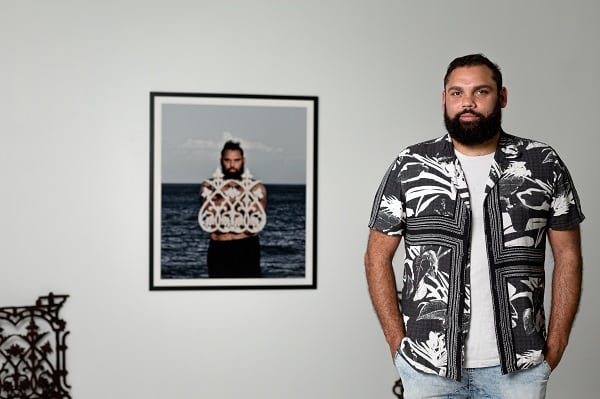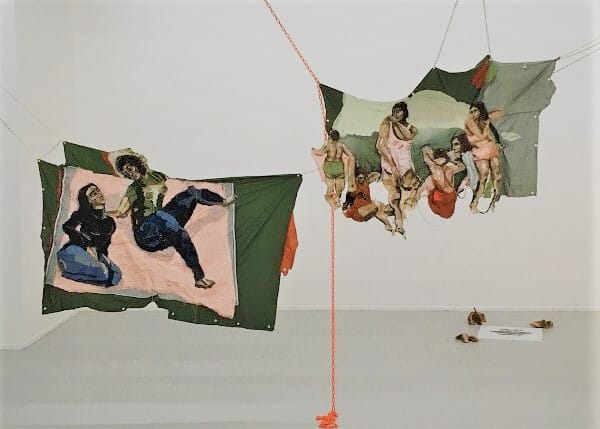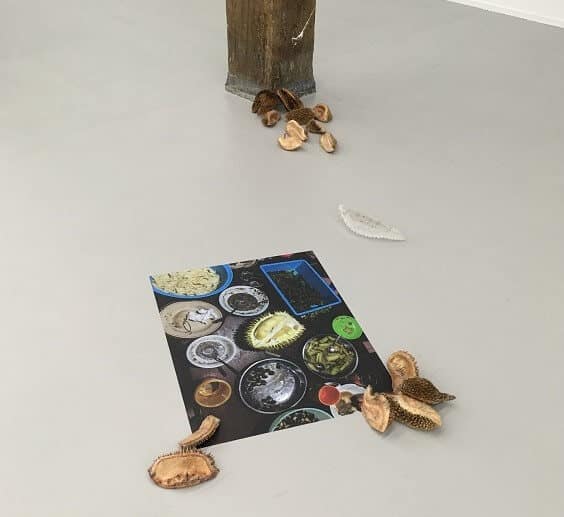What’s the ‘NSW Visual Arts Emerging Fellowship’ all about? The exhibition and award is supported by Create NSW and Artspace with a vision to encourage new contemporary arts practice. Each year one NSW-based visual artist working in the early stages of their career is selected from a cohort of exhibiting finalist artists to participate in a self-directed program of professional development.
We congratulate Kamilaroi/Gamilaraay artist Dennis Golding, who was awarded the $30,000 fellowship for his work titled Cast in cast out (2020). As well as celebrating Golding’s artistic accomplishments this momentous occasion recognises Golding as the first Aboriginal artist to win the fellowship in over 100 years of its history.
Sharing his joy Golding says, “Winning the fellowship gives me the opportunity to expand my practice in sharing stories of Aboriginal cultural identity through contemporary expression. It’s an achievement which extends to my family and my community, and I’m excited to continue working with them as part of this program to share our history and lived experiences. I’m greatly honoured to be the first Aboriginal person to win this fellowship and I’m hopeful for the future that our people can be much more represented in the contemporary art sphere.”

Throughout his practice Golding utilises the mediums of painting, video, photography and installation to produce work that challenges the social, political and colonial representations of Aboriginal people.
Delighted by Golding’s win co-curators of the finalist exhibition Alexie Glass-Kantor and Elyse Goldfinch said, “it is timely that this accolade aligns with NAIDOC Week and important recognition of Australia’s First Peoples. Golding’s work Cast in cast out stems from memories of the Victorian lacework that lined the terrace houses in his childhood suburb of Redfern and throughout the work’s development the artist consulted with family, community and peers to embed shared lived experience into the installation. Spanning artistic and curatorial disciplines, Golding is an emerging leader in his community, and we are excited to see where this opportunity will take his continued research and practice.”
The 2020 ‘VAEF’ finalist exhibition is on display at Artspace until 13 December showcasing new site-specific works by all eight emerging artists: Akil Ahamat, Tarik Ahlip, Tiyan Baker, Kate Brown, Dennis Golding, Julia Gutman, Nadia Hernandez and Kirtika Kain.
I dropped in on the show recently and was immediately taken by a sense harmony flowing throughout the gallery, evidence of collaborative motion brings focus to the subtle interactions moving between the artworks and their placement within the space; on the walls, suspended from overhead, strung between and on posts, or arranged across the floor.
“The artworks make contact with one another and interrupt sightlines in an intentional gesture informed by a desire to find connection and exchange,” the curators note.

Julia Gutman’s work No one Told Me the Shadows Could Be so Bright (2020), forms a large-scale installation of four textile pieces made using remnants of clothing donated by close friends of the artist, including one friend who passed away last year. Gutman’s striking and powerful portraits of women in her life are imbued with personal and spiritual notions of friendship, love and loss. Gutman’s intimate reflections are captured in meticulously crafted collages of fabric, wire and thread.
Kirtika Kain presents The Solar Line (2020), a series of 30 re-purposed silk screens trailing the gallery walls. One particular piece, which you see from the entrance to the gallery, acts as a beacon of light drawing you towards its richly textured gold leaf surface, under which lies artist-rendered text from the ancient Hindu legal book of the Laws of Manu (circa 100 CE) – archaic scriptures classifying caste and patriarchy. Throughout this body of work, Kain who is a Dalit woman born into the former ‘untouchable’ caste, expresses concern for the continued use of the ancient laws to justify caste and gender violence in India today.
Arranged at intervals across the expanse of the gallery’s floor are segments of Tiyan Baker’s installation juruh (the thorn in durian), (2020), an homage to the durian fruit of Malaysia. In the Western world durian is seen as malodorous and unpalatable, but in Malaysian culture durian is a source of wealth and nourishment. Baker highlights the significance of the fruit for her family who, following in the traditions of their ancestors, continue to grow wild species of durian trees. The scent of durian lightly permeates the air, in one corner are two small boxes amid an array of durian casings, to further test your olfactory senses move closer and inhale.

Here I mention just a few of the extraordinary artworks in this beautifully curated exhibition. Visit Artspace in Sydney’s Woolloomooloo to explore more of what these talented emerging artists bring to the landscape of contemporary art in Australia. This is a must-see exhibition!
You can also tune in to a two-part series of talks between the artists and the curators, live online via Zoom. Part One: Akil Ahamat, Tarik Ahlip, Tiyan Baker and Kirtika Kain. When: Wednesday 18 November, 2pm. Register here. Part Two: Kate Brown, Dennis Golding, Julia Gutman and Nadia Hernández. When: Wednesday 25 November, 2pm. Register here.